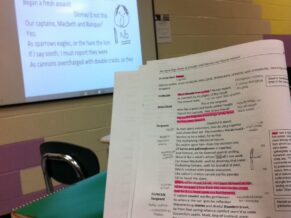This school year, at EdTechTeacher, we are doing our first iPad T21 program. During our second face-to-face workshops, our participants raised an excellent question: how do we actually USE these in the classroom? This seems to be a common thread throughout the blogosphere as educators grapple not with finding apps, but the challenge of truly transforming teaching and learning with these new devices.
When not working as an EdTechTeacher instructor and presenter, Greg Kulowiec is a history teacher and Technology Integration Specialist at Plymouth South High School. In the latter capacity, he collaborates with teachers to successfully integrate iPads into their curricula. Before beginning any new project, Greg asks, "How can we leverage technology to create an environment where students are able to share, demonstrate their understanding & create something that others can use in the future?" With the primary goal to create unique learning environments, Greg and his colleagues have created some transformational learning experiences this fall.
For teachers looking to see how iPads can truly be used to create learning experiences, here are three examples chronicled on Greg's blog: The History 2.0 Classroom.
iPads X Calculus X Educreations
Greg collaborated with a math teacher to create a system where students who were able to solve specific problem types could help those who struggled with the same challenges. Using Educreations, a screen casting app, students demonstrated their understanding while simultaneously creating tutorials for their peers.
In this English class, the teacher has an iPad though none exist yet for the students. This dynamic exists in many classrooms. At this juncture, the teacher wanted to address note taking as it coincided with the reading of Macbeth. Greg helped her to connect the iPad to a projector and use the GoodNotes app to annotate a PDF copy of the play. Since all of the students had the same PDF version of the text, they could work to annotate their copies in a similar fashion and have the teacher version for future reference.
My suggestion would be to scaffold this process, whereas the teacher spends a day or two modeling effective active reading and notations. Once students are aware of the classroom expectations, specific notations symbols, and are comfortable with the process, the students can take over the iPad and be responsible for displaying their active reading process.... commented Greg.
iPads X Geometry X Wix X ExplainEverything
This third blog post illustrates a great evolution to the iPad. At the beginning of the year, Greg taught this Geometry teacher about screencasting as a means for having students actively demonstrate their knowledge and understanding. With the introduction of the iPad, they were able to rapidly create even more content and then easily publish the final product to the web. What's interesting about this post is the evolution of the technology. As Greg and his colleague dug into the technology, they realized that in order to create a scalable and sustainable solution, they needed to make adjustments part-way through the process. As educators, we often shy away from such tactics. However, as Greg illustrates, evolution is really just another part of the process.

